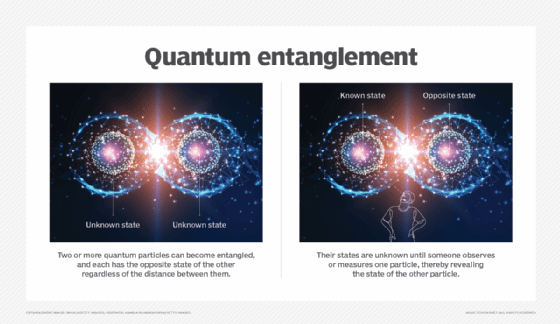What is quantum entanglement and how does it work?
Quantum entanglement is a foundational phenomenon in quantum mechanics where two or more particles become interconnected in such a way that the state of one particle instantly influences the state of the other, regardless of the distance separating them. This correlation occurs even when the particles are light-years apart, defying locality and causality principles of classical physics. Entanglement is a key aspect of quantum mechanics, belonging to the broader category of quantum phenomena that also includes superposition and wave-particle duality.
In the context of quantum computing, entanglement plays a key role by enabling quantum bits (qubits) to exist in multiple states simultaneously, dramatically increasing computational power. This interconnectedness enables quantum computers to perform complex calculations at speeds unattainable by classical computers. Quantum entanglement is essential in quantum algorithms and error correction, and it's used to advance technologies such as quantum cryptography and ultrasensitive quantum sensors.
How quantum entanglement works
Quantum entanglement is one of the most baffling phenomena in physics -- so bewildering that Albert Einstein rejected it, calling it "spooky action at a distance." It contradicts everything we know of classical physics.
Consider identical twins: Born from the same origin, they share the same DNA and often demonstrate strikingly similar physical traits, behaviors and even predispositions. What one twin does can be quite predictable of the other. Regardless of how geographically separated these twins might be, their lifestyles and modes of behavior often show striking parallels, such as each might name their pet the same unusual name without knowing the other did so.
Similarly, all elementary and subatomic particles of the universe, such as photons, atoms and ions, originate from the same fundamental source. When scientists split any one of these particles into two or more divergent systems, researchers can predict their behavior even when they're separated by vast distances. Whatever happens to one qubit instantly happens in the opposite direction to its twin.
For instance, if laboratory tests force one qubit to spin clockwise, its extremely remote twin will simultaneously spin in the opposite direction. Similarly, the very act of measuring any one of these qubits causes its infinitely spinning quantum state to solidify or collapse, with the identical same-moment reaction happening to its paired particle at the other end. Their communication is instant when researchers measure one of the qubits.
Additionally, contrary to Einstein's theory of relativity -- which states that nothing, including information, can travel faster than the speed of light -- communication between two paired qubits is faster than light even across immense distances. They have a special, almost telepathic way of communicating.

Quantum entanglement in the lab
Most researchers who test quantum entanglement use photons, tiny packets of light that are relatively easy to generate, manipulate and detect and more resistant to environmental noise than some other quantum particles. Researchers typically pass a single photon through special crystals that split the photon into two separate particles. These entangled photons are then directed along distinct paths using mirrors and optical fibers. To detect entanglement without disturbing the particles' fragile states, researchers use Bell state measurements specifically designed for this purpose. Bell states are the four possible quantum states of two qubits in maximal entanglement.
In addition, to ensure both "twin" photons maintain their entanglement and to monitor their behavior, researchers use a specialized beam splitter. This enables them to evaluate how the paired photons react when one photon's properties, such as its polarization or direction, are manipulated. In his 2010 book, Dance of the Photons: From Einstein to Quantum Teleportation, Anton Zeilinger, a Nobel prize winner for work on quantum entanglement and teleportation, compared this process of quantum entanglement to choreographing the tiny particles of light into a perfectly synchronized dance and harmonizing their movements with exquisite precision.
What is quantum entanglement swapping?
Instead of directly teleporting the state of a single particle across vast distances, researchers investigate the transfer of entanglement from one pair of particles to another, even if the two pairs have never directly interacted.
For example, in a 1998 paper, Zeilinger and his colleagues demonstrated how a precise measurement on one entangled pair of photons (A and D) could remotely entangle two other photons (B and C) that had never interacted with them. The first pair influenced the second pair despite being physically separated and having no prior interaction.
In 2017, Jian-Wei Pan's team tested for entanglement swapping over great distances and across complex networks. Their work used satellites to swap entanglement between ground stations located hundreds of kilometers apart and was designed to identify challenges and possibilities of building large-scale quantum networks that could eventually span continents or even the globe.
Physicist Douglas Youvan suggested in a 2024 paper that quantum entanglement swapping can be used to secure data transmission over vast distances through quantum relays -- which extend quantum communication -- and teleportation networks, among other benefits.
Quantum entanglement use cases
As baffling as it sounds, quantum entanglement has enabled scientists to produce potentially revolutionary technology, including the following:
- Cryptography. Quantum properties have shown benefits for sharing encoded messages securely. Entanglement ensures that any deviation from the expected result signals that the communication channel has been tampered with, alerting users to potential hackers. Another application is quantum key distribution (QKD), the secure exchange of cryptographic keys between two parties. Companies engaged in QKD research and development include Quantum Motion, Terra Quantum and other startups working to advance quantum technology. They aim to extend the range of QKD networks by enabling entanglement distribution over longer distances and through more complex networks.
- Quantum computers. These computers use entanglement to solve specific problems much faster and more accurately than even supercomputers. For example, Google's Sycamore quantum processor solved a complex mathematical problem in just 200 seconds that would take the world's fastest supercomputer 10,000 years to complete. Quantum computing is already solving major problems in areas such as cybersecurity, drug development, logistics, forecasting and machine learning. It speeds up genetic research for safer drug development, improves cargo operations, enhances real-time forecasting and could also transform climate modeling, finance and materials science.
- Quantum sensing. Using quantum entanglement to detect extremely faint signals or subtle changes in things like magnetic fields, gravity or even biological processes, quantum sensing leads to much more precise measurements than possible with regular sensors. For example, Australia-based Q-Ctrl develops quantum sensors to detect subtle changes in magnetic fields and gravity.
Cutting-edge work is also being done on quantum teleportation, where researchers focus on transferring the quantum state of a qubit from one location to another without physically moving the qubit itself.
Problems of quantum entanglement
The biggest problem is quantum decoherence. For quantum systems to produce the most productive results, they must be vast and complex -- conceivably intergalactic, spanning galaxies rather than merely countries or continents. However, the longer the distance and more complex the system, the harder it becomes to shield entanglement from quantum interference, which makes it difficult to keep the entanglement stable. Entangled quanta are extremely sensitive to even the slightest disturbances.
In laboratories, researchers work in ultracontrolled environments using highly precise lasers and detectors. In intergalactic settings, even the slightest bit of noise can easily distort these delicate systems. Scientists are exploring ideas such as special ways to encode quantum information to protect it from errors, known as quantum error correction; techniques to make the entanglement stronger, known as entanglement purification; and certain types of photons that could travel through space with less interference.
Beyond decoherence, other challenges with quantum entanglement include the following:
- Creating and maintaining entanglement. Generating strong entanglement between multiple subatomic particles requires precise control, making it difficult to scale while keeping their delicate states stable.
- Measurement problem. Measuring an entangled particle collapses its state and instantly affects its partner. Understanding this measurement process is a key area of research.
- Distribution over long distances. Reliably sharing strong entanglement over long distances remains a significant technological challenge for quantum networks.
History of quantum entanglement
Back in 1927 at the fifth Solvay physics and chemistry conference in Vienna, Danish physicist Niels Bohr introduced a revolutionary theory about a principle of quantum mechanics, proposing the existence of tiny particles that only have permanence at the moment they are observed, and that the act of observation itself changes their quantum state.
But for Einstein, there must be an objective reality independent of our observation. So in 1935, Einstein, Boris Podolsky and Nathan Rosen published a famous paper on what became known as the EPR paradox. In it, they argued that because quantum theory cannot precisely predict certain things, such as the position and momentum of entangled particles at the same time, there must be hidden variables that could explain these puzzling connections without needing to involve spooky action at a distance. Einstein considered the phenomenon of quantum entanglement "spooky" since it contradicted three of his theories:
- Locality theory. This states that an object can only be influenced by its immediate surroundings. Influencing something in a completely different location should be impossible.
- Relativity theory. This states that nothing can travel faster than light. Since light travels at 186,000 miles per second, if the particles communicate instantly, then there must be something else that travels faster than light -- something not known to present-day physics.
- Realism theory. This states that things exist independently of measurement. In contrast, systems in quantum entanglement achieve a definite state only when measured.
Twenty-nine years later, in 1964, Irish physicist John Bell published a mathematical theorem in a paper on the EPR paradox that disproved Einstein by demonstrating that even if atoms did possess such hidden variables, the nonlocality problem persisted. Particles could still influence each other across great distances, and atoms would still appear to communicate with their pairs faster than light.
While Bell's work initially went largely unrecognized, the 1960s -- a time of the Woodstock music festival and New Ageism -- paradoxically saw hippie physicists in Berkeley popularizing Bell's theorem through books such as The Tao of Physics, which posited that Eastern philosophy and quantum entanglement both described a deep connectedness of things in the universe.
However, Bell's theorem still needed experimental verification. In 1972, John Clauser and Stuart Freedman directed a laser at calcium atoms, causing the atoms to emit pairs of photons that quantum theory predicted would be entangled. They carefully recorded whether the photons passed through polarization filters on each side and checked how often the results matched. After hundreds of thousands of measurements, they found strong correlations that supported quantum entanglement, and their results closely matched Bohr's quantum mechanics predictions.
In 2022, the Nobel Prize in Physics was awarded to Alain Aspect, John Clauser and Anton Zeilinger "for experiments with entangled photons … pioneering quantum information science." Their groundbreaking work, including tests using devices that analyze polarization, provided strong evidence for the reality of quantum entanglement and challenged local hidden variable theories, thereby reinforcing the foundations of quantum mechanics.
How organizations can begin using quantum technology
According to William Wilson, executive director of the Center for Nanoscale Systems at Harvard University, the ramifications of quantum entanglement are magical. On a global scale, they could reveal to us more about human consciousness and the origins of the universe -- even how the universe might end. Entanglement could revolutionize computing and communication and help sensors detect extremely faint signals or subtle changes in magnetic fields, gravity or even biological processes more acutely than ever before.
Organizations can benefit from technology that uses quantum entanglement by investing in research and development to understand its principles and applications. Alternatively, they can collaborate with academic institutions and technology firms to gain access to their expertise and resources.
The use cases of quantum technology are vast. Organizations might invest in quantum computing to tackle complex simulations that classical computers struggle to handle. Others might use quantum cryptography to strengthen their data security, especially in sensitive sectors such as finance and healthcare.
Strategic partnerships can play a helpful role by enabling organizations to collaborate and experiment with entangled systems, pooling resources and expertise to accelerate progress in quantum technologies. Examples include setting up small-scale quantum networks to test entanglement-based communication or developing entangled sensors for enhanced measurement capabilities.
One thing is clear: The more entanglement-based technologies become more practical and accessible, the faster technology and science will advance, making a science that once seemed so baffling a reality.







